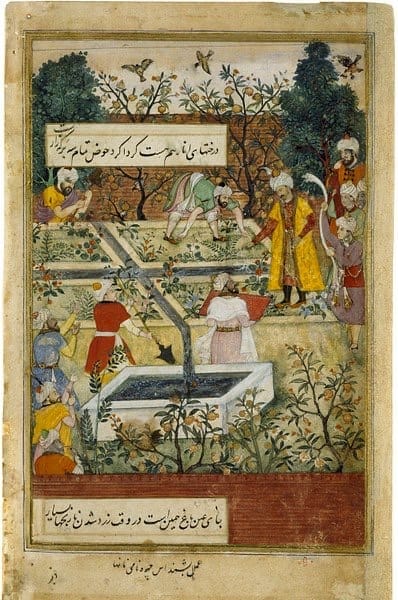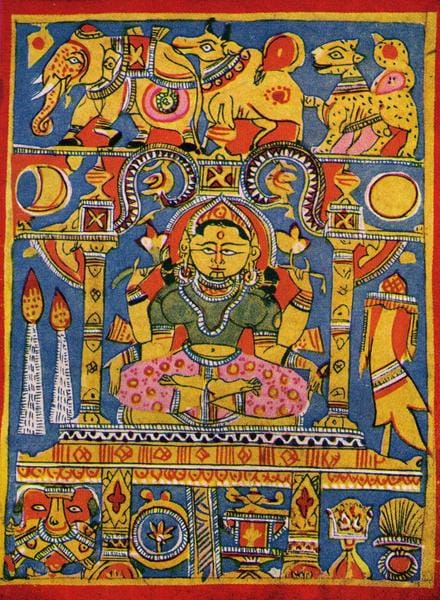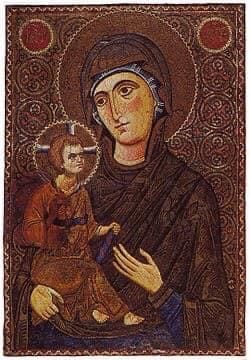Indian Floral : For centuries, plants and flowers have inspired Indian artists of different genres. The lotus flowers and floral meanders depicted in the Buddhist sites dating back to the 3rd century, the depiction of Hindu God Vishnu on a throne of a lotus flower, and the famous paintings of Ajanta and Ellora caves from the 5th century are the most excellent and oldest examples depicting florals in Indian Art. However, florals did not become the design language for Indian textiles for a long time, not until the beginning of the Sultanate Period in the twelfth century when Islamic culture started influencing Indian art & design.
Indian Art
The history of painting in India goes back 2000 years, something that many do not realize, starting with the beautiful murals of Ajanta, which are interesting too because they show people wearing craft still extant. The 11th century saw the illustrated Pala manuscripts, painted on palm leaves, and the earliest example of miniature painting in India. The next development was the Jain school of Gujarat, which eventually lead to the Rajput tradition of miniature art. As it grew and developed, the Rajput tradition divided into two distinct schools, Rajput and the Pahari school, based in Himachal Pradesh, the hilly state in the north-west of India.
I will start teaching my first course on ‘Collaborative Design with Artisans’ as an Adjunct Professor at FIT from the coming Saturday. This new opportunity encouraged me to read about handmade textiles from a global perspective. I read some exciting books from the V&A Museum’s Textile and Fashion collections. It is a very enriching experience to learn from other cultures. This reading and research have helped us enhance our design approach and library at Marasim. As I am hopeful, it will also help further the knowledge of my soon to be students.
There is something about the miniature, but perfect and complete that gets me every time. And I know I’m not the only one. Is it an adult fascination with dollhouses? Or the desire to control a tiny universe? I don’t know. But Micromosaics have always fascinated me.
MUGHAL & DUTCH: A CULTURAL BRIDGING OF 2 GREAT ARTISTIC TRADITIONS
THE MUGHAL EMPERORS LOVE FOR BEAUTIFUL FLOWERS AND FLORAL DESIGNS
Mosaics have been around from the third century BC, particularly in Ancient Rome, composed of glass and terracotta. However, they came into their own in the Byzantine era, where they adorned the churches. This tradition was continued during the Renaissance, as in the ceiling of St Peter’s Basilica by Michaelangelo.

Bābur supervising the laying out of his Charbagh The Garden of Fidelity. Opaque watercolor and gold on paper
India – ca.1590
Artists: Bishndas and Nanha From the V&A
Mughal Floral Designs – South Asian art has always been full of floral images, but this reached its zenith in the Mughal empire. During the 330 years that the dynasty ruled, most magnificent art, architecture, and craft that the world has seen were produced, and much imagery used was from flora, particularly in the reigns of Jahāngīr and Shah Jahan. However, Bābur, Humayun, and Akbar are all recorded as profoundly interested in gardens and flowers. One of Babur’s first actions in India was to make a garden, the Charbagh.
The popularity of floral motifs in Mughal art was because traditionally, living creatures and humans were not supposed to be depicted in Islamic art. Therefore, the plant kingdom provided subjects that were non-controversial and capable of stylization.
MATISSE’S ART AND TEXTILES: Last week, As I was researching the works of artists who found inspiration in textiles, I came across the book ‘Matisse: His Art and His Textiles.’
Matisse had a blood association with textiles as he was born to a family of expert weavers in the French town of Le Cateau-Cambresis and brought up at Bohain-en-Vermandois in Picardy in Northern France. Since the Middle Ages, this region had been the center for manufacturing textiles- linen, wool, and silk. By the end of the nineteenth century, when Matisse was growing up, Bohain was renowned as a luxury fabric producer. – embossed and patterned velvet, tulle, voile, and above all, silk. It was second to none in supplying the top end of the Paris fashion trade.




